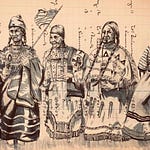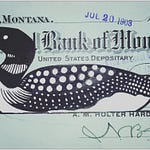Oki, Nikso’kowaiks.
This week, I continue my four-part series on the history of Ledger Art. Last week, I discussed the 19th-century origins of the art form and explained that the actual origin of the tradition is much older. In this third installment, I go into the art form’s true origins and how it almost disappeared.
OLD AS TIME
When I stated that the roots of Ledger Art are older than paper, I was not exaggerating. It’s not just “older,” it’s “way older.” The first paper, as we know it, was created around 200 BCE in China. In elementary school, I remember learning that the word “paper” is derived from “papyrus,” the Ancient Greek word for the Cyperus papyrus plant. Ancient Egyptians would slice the papyrus plant into thin strips, laying them side-by-side. Then, after adding a second, perpendicular layer, the two would be pounded together and dried. In this form, paper was used as early as 3,000 BCE.
So, paper in some form is almost five thousand years old. That’s pretty old.
But it is still not as old as “Dusty” Crawford’s family.
In 2019, Kristen Inbody published Daryl “Dusty” Crawford’s story in the Great Falls Tribune. Crawford had his DNA tested at the request of his late brother, who had wanted to compare results.
"I just wish I could have shown it to him.” Crawford told the Tribune, “It would have blown him away."
The results were indeed remarkable. Crawford’s test came back with a 99% accuracy rating going back 55 generations! The company Crawford used, CRI Genetics, states that they have never been able to trace ancestry in the Americas back as far as they did Dusty Crawford’s. His DNA placed his ancestors in the Americas about 17,000 years ago. So, for those doing the math, that means Dusty Crawford’s great, great, great… (it’s a lot of greats) …great granddaddy was chillin’ in Arizona fourteen to fifteen thousand years before paper was even invented!
This information is extremely important for Indigenous people in North America for a number of reasons.
For one, it validates their claim to visibility. More than five hundred years have passed since Christopher Columbus found himself on American shores. Since then, European settlers have done their best to erase Native history, language, and culture. But it is not just those of European descent. A disturbing trend on Social Media over the last several years has seen a small population of Black Americans claiming to be the original inhabitants of North America.
Native Americans have long made the claim that they have “always been here,” but if you grew up with a public school education in the United States, you may remember being taught that humans migrated from Eurasia through the Bering Straits—a land bridge between Alaska and Russia.
Crawford’s test demonstrates that Native people predate the Bering Land Bridge theory by centuries and provides some of the evidence that has since debunked this theory. It also supports the assertion that Native peoples have “always been here.” This is incredibly important for validating claims to land and cultural history.
It is that history we are currently interested in.
WINTER COUNT
Blackfoot elder, artist, and musician Ira Provost explains, “A winter count was a tanned hide or robe of a buffalo where symbols were drawn on the surface. The images drawn consisted of significant events that occurred to the group of people in possession or who owned the hide.”
Click here to see Provost’s wonderful exhibit Piikanikoan: Living under a Blackfoot Sky: A Modern Winter Count
As I said previously, prior to the Gregorian calendar, the Blackfeet counted years according to winters. A tribal historian would have the responsibility of keeping the count and recounting the oral history of the people based on the symbols inscribed on the hide. These symbols, called pictographs, are simple and today would be described as “primitive,” but they hold the key to understanding important events in Blackfoot history, if one can decipher them.
Pictographs can tell the number of horses a warrior was able to steal, the number of victories in battle, the number of times a warrior counted coup, and much more. It could mark illness or disease, and a natural phenomenon as well.
For the uninitiated, Counting Coup comes from the French language, meaning “blow” or “cut.” It is a Piikani custom shared by other plains people in which a warrior elevates his status by showing bravery in battle by humiliating or intimidating the enemy without killing them. The warrior may steal an enemy’s weapons or horses, strike an enemy without killing them, or force a surrender. These victories would be remembered and recounted through Winter Counts.
Winter Count is also a source of Cultural Identity. Prior to the colonization of the Americas, there was no border separating the U.S. and Canada. While the Blackfeet Nation is one of the nearly 575 recognized tribes in the United States, three of the four bands of the Confederacy exist in Canada. Those three bands are among more than 630 First Nations communities, meaning there are more than 1200 different cultures north of the Mexican border. While there are some shared similarities in practices and language, like the Niitsitapi, there are still hundreds of cultures that are nothing alike.
As I previously discussed in the second installment, the buffalo were all but extinct by 1890. The mass slaughter of the American bison by European settlers is well-known and documented. It was an economic and environmental disaster as much as it was an act of genocide. Economically, it provided a short-term boost for those trading in the hides, but it was not a sustainable one. Environmentally, the act decimated ecosystems across the continent, with long-term effects still felt today. For the people whose lives revolved around the buffalo, it starved and robbed populations of the resources needed for their day-to-day existence.
With the eradication of the American Bison came the introduction of Indian Residential Schools. Under the guise of education and better preparing Native children for roles in American society, the U.S. and Canadian governments, along with the church, set up boarding schools. Children were removed from their families at a very young age and stripped of their hair, language, and cultural identities. These schools have left a legacy of intergenerational trauma, with thousands of graves left behind as proof of the rape, abuse, and “killing the Indian,” to “save the man.”
With the traditional ways all but gone, the Art of the Ledger was all but extinct. But Indigenous people are as strong as they are resilient. Secret Societies kept the Blackfeet language and traditions alive. They hid away sacred bundles and items important to their spiritual practices. On August 11th, 1978, the Indian Religious Freedom Act was passed, and the culture that had been kept in secret was finally able to be practiced openly. In 1997, the last of the Residential Schools was closed, and the long process of healing could begin.
THE RESURGENCE OF LEDGER ART
Ledger Art began a resurgence in popularity during the during the 1960s and 1970s. Indigenous artists like the late George Flett (Spokane/ Salish) began creating contemporary works using documents from the 1800’s. A graduate of the Institute for American Indian Arts in Santa Fe, New Mexico in the mid 1960s, Flett used ledgers to tell the stories of the Spokane history or legend.
Kiowa artist Stephen Mopope was the eldest of the group known as the “Kiowa Six,” and was the nephew of Ft. Marion Ledger Artist Ohettoint, who taught him traditional painting techniques. Mopope’s work and that of the Kiowa Six bridged the gap between the generations and would inspire contemporary ledger artists like Terrance Guardipee, Dolores Purdy, and others.
Next week, I will conclude my series with how I was introduced to the Art of the Ledger, and which artists you should watch for.











